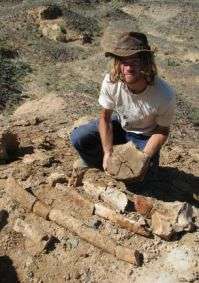Polar dinosaurs may have taken shorter treks

(PhysOrg.com) -- Contrary to popular belief, polar dinosaurs may not have traveled nearly as far as originally thought when making their bi-annual migration.
University of Alberta researchers Phil Bell and Eric Snively have suggested that while some dinosaurs may have migrated during the winter season, their range was significantly less than previously thought, which means their treks were shorter. Bell and Snively's findings were recently published in Alcheringa: An Australasian Journal of Paleontology.
The idea that these animals may have travelled distances nine times further than mule deer or four times those of wildebeest would have made them the greatest migrators in history. "There are strong opinions regarding dinosaur migration, but we decided to take a different approach, looking at variables such as energy requirements," said Bell. Their research led them to suggest that migrating dinosaurs could have travelled up to 3,000 kilometres in a round trip-lasting perhaps up to six months-half of the distance suggested previously.
According to Bell, the notion of migrating polar dinosaurs is not new; however, previously-held beliefs were that the animals followed the centrally shifting sunlight, or latitudinal "sun line," as part of their migration and would travel as far as 30 degrees of latitude, or 3,200 kilometres, in order to survive. Given their size and physiology, Bell and Snively have concluded that dinosaurs would have been incapable of sustaining the effort needed to make the trip. "When we looked at the energy requirements needed to support a three-tonne Edmontosaurus over this distance, we found it would have to be as energy efficient as a bird. No land animal travels that far today," said Bell.
Bell does not dispute the evidence of migration and points to discoveries of large bone beds as evidence that many dinosaurs also traveled. In order to sustain the herd, "it seemed to make sense that they would be moving to and from the poles," he said.
While this view of migration is feasible for some species of polar dinosaurs, it does not hold for all, Bell noted. "Many types of dinosaurs were surviving in polar latitudes at the time, and getting along quite fine," said Bell. "They were not physically able to remove themselves from the environment for a variety of reasons and had to adapt to the cold, dark winters just as the rest of us mammals do today."
Provided by University of Alberta



















